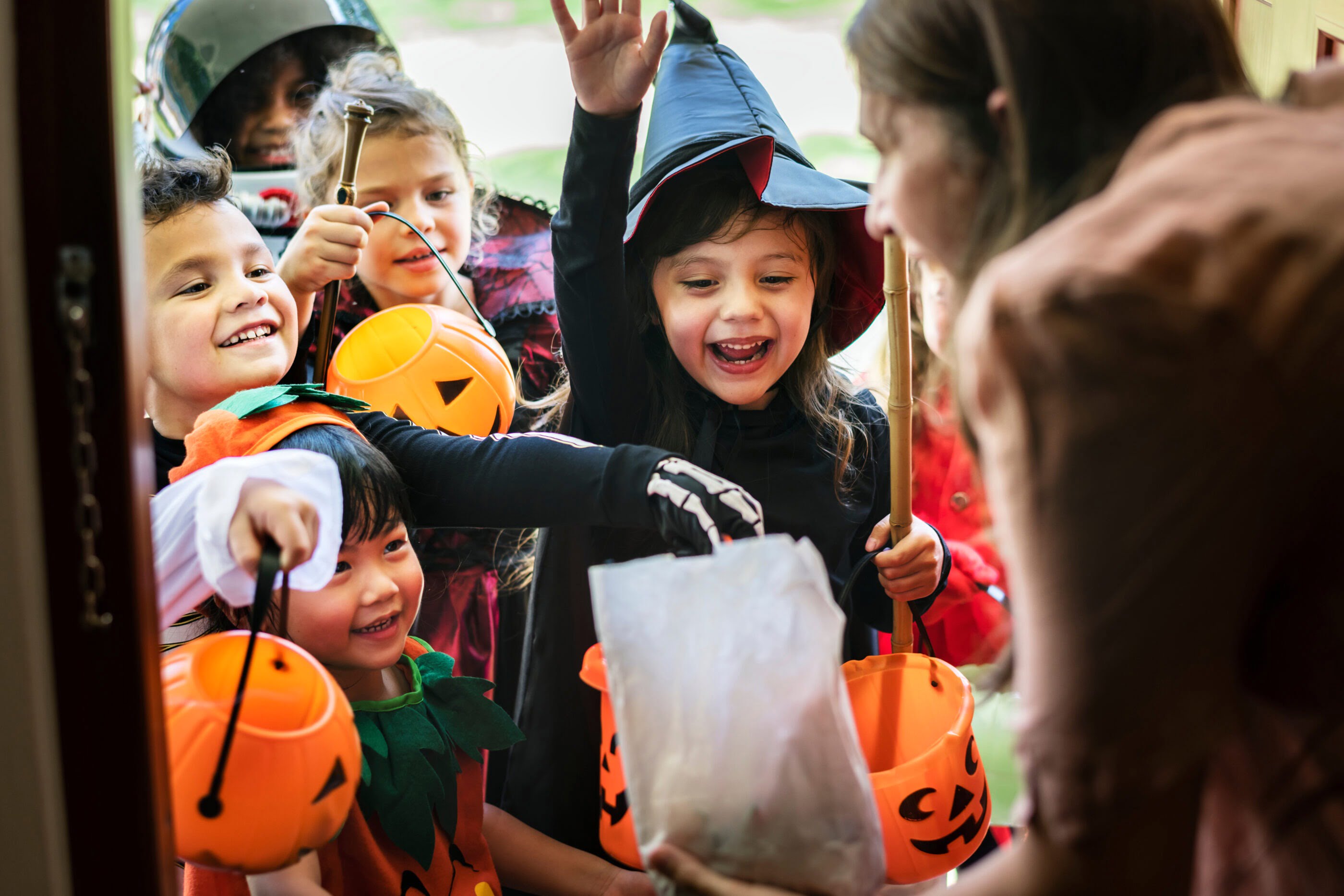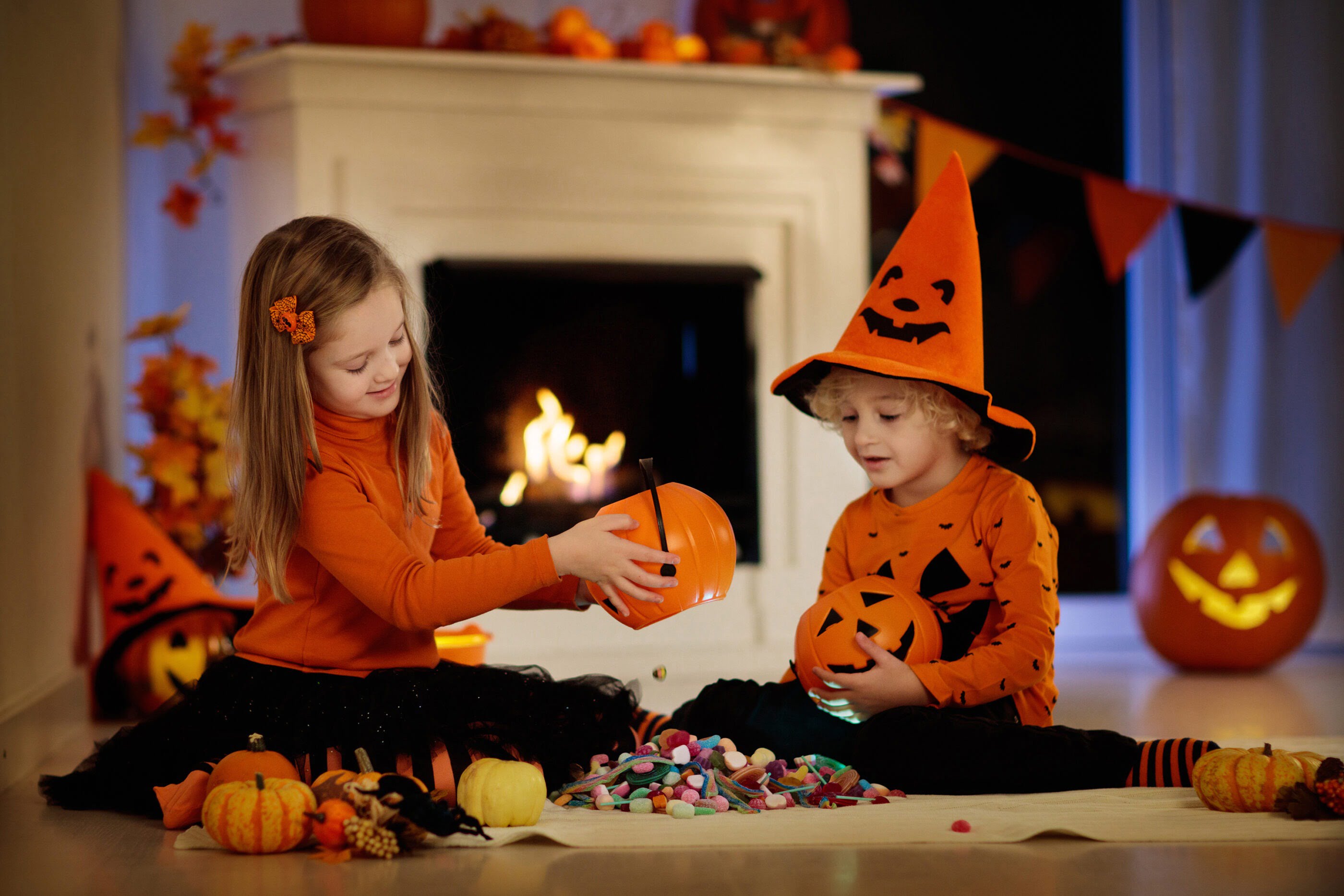The holidays are a time for family, food, and fun—but let’s be real, they can…
Halloween for Kids: Building Positive Relationships with Food
As Halloween approaches, feelings of both excitement and dread may emerge in anticipation of the candy cornucopia that is soon to pour into the homes of all who celebrate this spooky holiday.
As a dietitian and mom of three, I am here to reassure you that Halloween candy will not trigger treat-obsession or an ‘addiction to sugar’. In fact, Halloween can be a perfect opportunity to do the exact opposite by helping your child strengthen their relationship with food, especially when it comes to sweets!
Here’s how to take the fear out of Halloween candy and turn it into a fun, explorative experience for your kiddos:
Talk about Halloween candy in a neutral way
For some, Halloween might just be a fun family holiday to look forward to. For others, it can cause a lot of distress. When your household strategy is to keep treat foods “out of sight” and therefore “out of mind”, the thought of your kids bringing home buckets of candy can understandably trigger feelings of anxiety and discomfort.
These feelings are 100% valid and actually make a lot of sense when we look at how diet culture has influenced society to demonize processed foods, added sugars and treats. If your current philosophy around Halloween candy is that of labelling it as “red-light foods”, “unhealthy”, or “junk”, you are not alone! Most of us now-parents grew up during a time when diet culture shaped how we thought about food, health and body image (and continues to do so today).
But we can break this cycle for our kids. In order for us to help nurture a healthy relationship with food in our children, looking at our own food beliefs and values is a crucial step.
Adopting the philosophy of food neutrality in your household strips food of its moralizing labels. The truth is, food is just food. It’s not inherently “good” or “bad”. Calling food by its name (e.g. candy is candy and kale is kale) is the easiest place to start when removing diet culture and restrictive language from day-to-day interactions with your kids! While candy certainly is different in its nutritional value than fruit and vegetables, it is important that our children know that they are NOT morally better or worse for deciding to eat and enjoy candy.
Children haven’t yet developed abstract thinking so they often will absorb dichotomizing food labels like “unhealthy” or “bad” onto themselves. For example, if mom calls chocolate bars “fattening” they may think they are or will get fat for enjoying chocolate. You can see how this is damaging their body image and relationship with food in the long run!
My challenge to you? When your child comes home this year from trick or treating, try your best to hold back on restrictive language or micromanaging tendencies that may be itching to come out. Instead, explore their loot with them in a neutral and curious way. How does the candy taste, smell, and feel when it melts in their mouth? Maybe they like certain treats more than others.
Follow the Division of Responsibility
You may be wondering how eating Halloween candy can possibly help kids learn about their bodies. It seems so counter-intuitive right? Let me give you some background on how Halloween candy is truly a wonderful opportunity for learning.
As parents, it is our job to determine when, where and what is offered to our kids according to Ellyn Satter’s Division of Responsibility (sDOR) in feeding (an evidenced-based feeding philosophy that I highly recommend). Kids decide if and how much of an offered food they eat at designated meal and snack times. So how does Halloween candy fit into this feeding strategy?
On Halloween night, I recommend parents take a step back and allow their kids to eat as much candy as they want! Seems scary right? However, giving them this freedom for one night tells your kids that you trust them to eat the amount of candy that feels right for their body, and allows them the excitement of exploring and organizing their own Halloween stash! Yes, some kiddos will eat so much candy that they will feel sick with a tummy ache. Others might surprise you with deciding to eat just a few, and save the rest for later. No matter what they decide, they will learn through this unique opportunity to self-regulate their candy intake by listening to their body signals of desire, hunger, satisfaction, fullness, or discomfort. At the end of it all, your child will learn an important lesson in intuitive eating and advance in their ability to interpret and respond to their body’s internal cues!
After Halloween night, go back to the sDOR structure and decide with your child what amount of candy each day seems fair. You know your child best, and you may feel comfortable giving them the opportunity to decide where they want to add their candy in the day (as long as it’s when the kitchen is “open” at a meal or snack time(s)!).
Model enjoying Halloween candy yourself!
It will surprise very few parents to hear that they are the most influential role model in their young child’s life. The way in which children see you interact, speak about and enjoy all different types of food, is no exception to this rule.
If they hear you say “Oh no, I can’t have any XYZ candy, if I start, I won’t be able to stop!” it sends the message that eating that candy will lead to loss of control and should be feared (well sheesh that’s no fun!).
I encourage you to sit down and enjoy Halloween treats with your kids! This helps to model that food is so much more than just eating for nutrition or fuel. In fact, Halloween candy can be so much FUN to eat, and enjoying it with family and friends helps create lasting memories!
But this is only true if you genuinely enjoy eating Halloween treats with your kids. Maybe candy isn’t up your alley, or you just don’t feel like it that day. That is 100% OK too. Just be sure to carefully navigate your language by saying something like “My tummy doesn’t feel like candy today, but I would love to try some tomorrow with you!” or “Actually, chips aren’t my favourite, but I do love chocolate cake.” Your kids will pick up on this! They will see that you choose to honour your flavour preferences and listen to what your body is telling you at that moment. Yet another wonderful life lesson you can role model for your kiddos in their journey to developing a healthy relationship with food!
How much candy is too much?
The answer to this question depends on the age of your kiddo. Babies and young toddlers (under 2 years old) have small tummies and high nutrient needs to support rapid growth and development. They just aren’t quite ready for Halloween treats at this age.
Toddlers between ages 2-4 years old are often still too young to manage their own candy stash and will benefit from parents deciding on a daily candy limit that seems fair and feels right for both the parent and child. For example, it might be decided that your 3-year-old gets 3 Halloween candies a day. However, to help them feel a bit of that independence they crave, it can work well to allow them to choose which meal or snack they want to add the candy to.
For older children, hand over the reigns! Like mentioned above, kids will only benefit if they are allowed to manage their own candy intake, free from restrictive limits. Micromanaging your older child’s candy just sends the message that they can’t be trusted to self-regulate their food intake and puts Halloween candy on a pedestal above other food.
Regardless of your child’s age, candy is only to be enjoyed when “the kitchen is open” at meal and snack times. This avoids the pitfall of grazing and snacking all day which often leads to mealtime battles and picky eating in kids.
Is Halloween candy safe for my child to eat?
No candy, chocolate, chip or gummy is unsafe for your older child to eat unless it has been tampered with, is a potential choking hazard, is expired or triggers your parent Spidey senses and gives you a bad gut feeling. Always inspect your child’s candy before they eat it to make sure that it hasn’t be opened, contaminated or tampered with.
Younger children may not have the developmental ability to safely eat certain types of Halloween candy. Halloween treats that are small and hard, round, chewy or gummy are all considered choking hazards and should be avoided by kids under 4. Be sure to go through your child’s candy stash to remove candies like Skittles, gummy bears, chocolate-covered nuts, Twizzlers, Jolly Ranchers, taffy etc. if they are too young. Larger, easier-to-chew treats such as peanut butter cups, Kit Kat bars, Hershey bars, cookies, Animal Crackers, and Butter Fingers are all safe for younger kiddos between 2-4 years old.
For some children, certain Halloween treats might not be safe for them to eat due to food allergies or intolerances. Some families choose to follow a vegan diet too! Spud stocks some yummy alternative options these kiddos can enjoy on Halloween (many of which are vegan as well!):
Gluten-free Halloween options
- Be Fresh Gummies
- Annies Bunny Fruit Snacks
- Schar Chocolate Honey Grahams
- Angies Boom Chicka Pop Cheddar puffs and popcorn
- FreeYumm Cookies
Dairy-free Halloween options:
- No Whey Chocolate
- Denman Island Chocolate
- Endangered Species Chocolate
- Yum Earth Strawberry Liquorice
Nut-free Halloween options
- No Whey Chocolate
- Yum Earth Strawberry Liquorice
- Be Fresh Gummies
- Annies Bunny Fruit Snacks
- Schar Chocolate Honey Grahams
Bottom line:
As Halloween approaches, rest assured that Halloween candy won’t lead to treat obsession or sugar addiction! It’s important to adopt a food-neutral approach and avoid labeling treats as “unhealthy” or “junk.” As a mom of three, I encourage you to explore and enjoy Halloween candy alongside your kids, while following the Division of Responsibility in feeding to help your kiddos self-regulate their candy intake. Ultimately, Halloween candy can be an opportunity to strengthen a child’s relationship with food and promote intuitive eating.
Meet Sarah
 Sarah Remmer, is a registered dietitian (since 2006) mom of 3 and the proud founder and President of The Centre for Family Nutrition, a Calgary-based nutrition counseling practice that specializes in prenatal, infant and child nutrition, that specializes in prenatal, infant and child nutrition.
Sarah Remmer, is a registered dietitian (since 2006) mom of 3 and the proud founder and President of The Centre for Family Nutrition, a Calgary-based nutrition counseling practice that specializes in prenatal, infant and child nutrition, that specializes in prenatal, infant and child nutrition.






